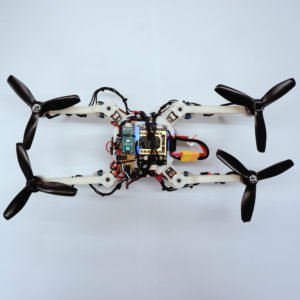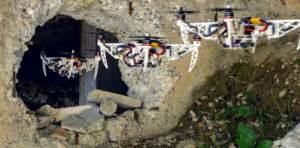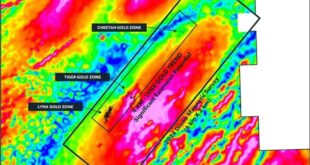Compact and foldable, portable drones are great for carrying – but can the advantages of a folding drone be realized during flight? Researchers at the University of Zurich, with others, have come up with a drone that folds during flight to get through tight spaces.
Davide Scaramuzza, Associate Professor of Robotics and Perception at University of Zurich writes, “The Foldable Drone: a morphing quadrotor that can squeeze through gaps, flatten against walls for up-close views, and even grab small objects with rotor arms! The work has just appeared in the IEEE Robotics and Automation Letters. This new drone has four independently rotating arms that fold around the main frame. To guarantee stable flight at all times, we exploit an optimal control strategy that adapts on the fly to the drone morphology. The experiments were performed using only on on-board visual-inertial sensors and compute. No external motion tracking systems and computers were used.”
DRONELIFE spoke with Davide Falanga, one of the researchers involved with the project.
DroneLife: What gave you and the team the idea of a drone that folds in flight?
Davide Falanga: In our lab, we focus a lot on robotics for search and rescue, and in the past we already tackled the problem of letting a quadrotor fly through narrow gaps using onboard sensing and computing. However, that approach required the vehicle to execute a very aggressive maneuver, which requires quite some space before and after the gap, and can be potentially dangerous for the robot. This motivated us to think about a different solution to this problem, and we came up with the idea of adapting the drone’s structure to the gap to traverse it.

From Subject of Interview
It looks from the video that the drone can rotate or collapse in a number of ways. Can you tell us more about how it works?
Davide Falanga: It is mechanically very simple: it has the standard structure of a quad-rotor, with the difference that each arm is connected to the main body through a servo-motor. Each servo-motor is controlled independently, and therefore the robot can assume potentially any configuration. The control system is aware of the drone’s morphology.
What is next for the project?
Davide Falanga: We plan to investigate novel folding techniques, as for example 3D folding, which can be beneficial for other tasks such as flying at very high speed. Also, we want to increase the level of autonomy of the vehicle (which is currently completely autonomous, since it does not require any human intervention and it is not controlled through a remote or a joy pad). To this aim, we plan to enable our drone to accept high-level commands, such as “explore this building and come back”, which requires it to analyze the building to find an aperture to enter it, decide the best morphology to traverse the gap, explore an environment which is not known in advance, and find its way back to complete the mission.
CEO DroneLife.com, DroneRacingLife.com, and CMO of Jobfordrones.com. Principle at Spalding Barker Strategies. Proud father of two. Enjoys karate, Sherlock Holmes, and interesting things. Subscribe to all things drone at DroneLife here.
https://dronelife.com/2018/12/14/exclusive-interview-agile-drones-that-fold-to-get-through-tight-spaces/
 Unmanned Aerial Vehicle The latest drone news
Unmanned Aerial Vehicle The latest drone news



